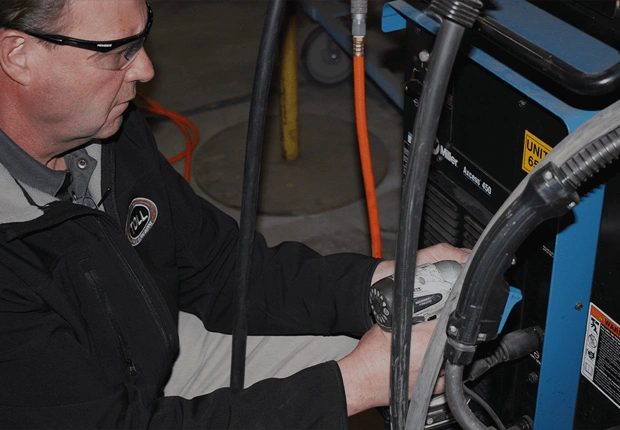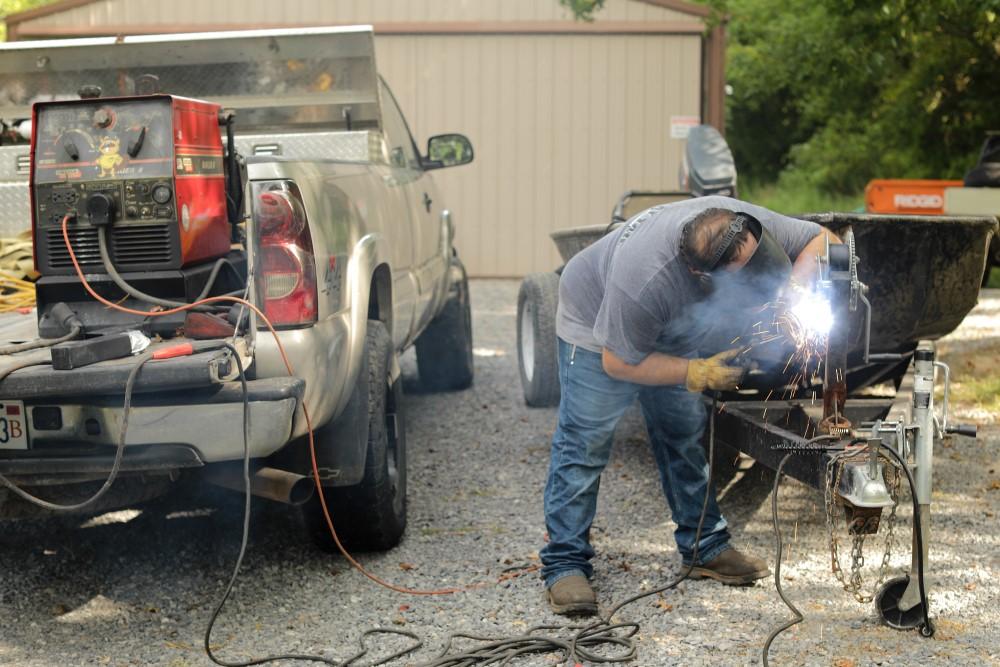Everything about Welding: Secret Insights Into Techniques and Ideal Practices for Success
Welding includes a variety of techniques, each fit for details materials and applications. Understanding these methods, such as GMAW, SMAW, and TIG, is crucial for attaining suitable outcomes. The right devices and safety practices can not be forgotten. As prep work and repairing play important roles in the welding procedure, understanding these elements can significantly enhance the top quality of the end product. What are the key aspects that ensure an effective weld?
Comprehending Different Welding Strategies
Welding techniques incorporate a range of approaches, each suited to details applications and products. Amongst one of the most common strategies are Gas Metal Arc Welding (GMAW), Shielded Metal Arc Welding (SMAW), and Tungsten Inert Gas Welding (TIG) GMAW, additionally known as MIG welding, is preferred for its speed and convenience, making it ideal for thin materials. SMAW, or stick welding, is favored for its simpleness and effectiveness in outside atmospheres, specifically with thicker metals. TIG welding supplies accuracy and control, making it appropriate for intricate work and non-ferrous steels (Belgrade Fabrication). Each method has its special benefits and factors to consider, enabling welders to choose the very best method based upon the task's requirements, product kind, and wanted outcomes. Comprehending these methods is important for effective welding
Important Welding Equipment and Devices
While numerous welding methods require details skills, the right tools and tools are equally vital for achieving high quality outcomes. Essential welding devices consists of welding equipments, which vary depending upon the strategy-- such as MIG, TIG, or stick welding. Protective gear, consisting of headgears, handwear covers, and aprons, guarantees security and comfort during the procedure. In addition, clamps and fixtures aid safeguard materials in area, making sure precision in welds. Consumables like welding poles, wire, and shielding gas are likewise vital components that influence the top quality of the weld. Additionally, devices such as grinders and cutters help with surface preparation and post-weld completing, contributing to an expert result. Investing in top quality devices eventually boosts the performance and efficiency of welding tasks.
Security Practices in Welding
Appropriate safety techniques are vital in the welding market to protect workers from possible dangers. Welders have to wear proper personal safety equipment (PPE), including safety helmets with proper shading, handwear covers, and flame-resistant clothing. Adequate air flow is crucial to reduce direct exposure to damaging fumes and gases created throughout the welding process. Furthermore, workers ought to be trained in the correct handling of welding devices to stop mishaps. Fire safety procedures, such as keeping flammable materials far from the welding location and having fire extinguishers readily available, are necessary. Routine evaluations of devices and work spaces can assist determine prospective dangers prior to they result in accidents. By sticking to these safety practices, welders can develop a safer working atmosphere and decrease risks connected with their profession.
Readying Materials for Welding
Preparing products for welding is an essential step that substantially influences the quality and stability of the end product (Montana Mobile Welding and Repair Belgrade Fabrication). Proper prep work includes cleaning the surface areas to eliminate impurities such as oil, dust, and corrosion, which can jeopardize the weld. Strategies such as grinding, sanding, or utilizing solvents are typically used to accomplish a tidy surface area. In addition, guaranteeing that the materials fit together snugly is necessary; gaps can lead to weak welds. It's likewise essential to take into account the placement and positioning of the elements, as this will impact the simplicity of welding and the last result. Ultimately, picking the proper filler material and guaranteeing compatibility with the base metals is vital for achieving strong, long lasting welds
Tips for Achieving High-Quality Welds
Attaining top notch welds requires interest to detail and adherence to best techniques throughout the welding procedure. Correct joint preparation is crucial, making certain surfaces are tidy and cost-free from pollutants. Selecting the appropriate filler product and welding technique based upon the base steels is important for suitable bonding. Keeping constant traveling rate and angle while welding can advertise and avoid flaws harmony. Additionally, controlling warm input is crucial; excessive heat Clicking Here can result in warping and compromised joints. Consistently evaluating the welds throughout the procedure permits immediate adjustments if required. Lastly, employing ideal post-weld treatments, such as cleansing and stress alleviation, can enhance the sturdiness and stability of the weld, ultimately guaranteeing a successful result.
Fixing Common Welding Issues
Welding commonly presents difficulties that can influence the top quality and honesty of the end product. Usual problems such as porosity, irregular weld beads, and getting too hot can arise, each needing details troubleshooting strategies. Recognizing these issues is necessary for welders to enhance their skills and achieve suitable results.
Porosity Troubles Discussed
Porosity can commonly be overlooked, it stays an important problem in welding that can jeopardize the integrity of an ended up product. Porosity describes the presence of tiny gas pockets within the weld bead, which can compromise the joint and lead to early failing. This issue normally occurs from pollutants, wetness, or inappropriate securing gas protection throughout the welding process. To alleviate porosity, welders should confirm that the base products are dry and tidy, make use of suitable protecting gases, and keep constant welding criteria. Visit This Link On a regular basis inspecting the tools and atmosphere can likewise assist determine potential issues before they manifest in the weld. Attending to porosity properly is crucial for achieving solid, resilient welds that satisfy quality criteria.

Inconsistent Weld Beans
Inconsistent weld grains can significantly impact the quality and strength of an ended up item. Numerous factors add to this concern, including improper travel rate, inaccurate amperage settings, and irregular electrode angles. When the welder moves also rapidly, a grain might appear narrow and do not have infiltration, while relocating also slowly can trigger excessive accumulation. Additionally, making use of the wrong amperage can cause either damaging or too much spatter, both of which concession weld stability. The welder's technique, such as irregular lantern movement, can additionally result in uneven grain appearance. To alleviate these problems, welders ought to concentrate on preserving steady, regulated check movements and guaranteeing appropriate tools setups to achieve uniformity in their welds. Uniformity is key to attaining solid and dependable welds.
Overheating and Bending Issues
Extreme heat during the welding process can result in considerable overheating and buckling concerns, affecting the architectural honesty of the workpiece. These problems frequently show up as distortion, which can endanger alignment and fit-up, making additional setting up testing. Factors adding to overheating consist of the choice of welding parameters, such as voltage and travel rate, along with the sort of product being welded. To mitigate these concerns, welders ought to maintain regular traveling speed and suitable heat input while checking the workpiece temperature level. In addition, preheating or post-weld heat therapy can help ease stresses triggered by quick air conditioning - Montana Mobile Welding and Repair Belgrade Fabrication. Regular evaluation and adherence to best methods are crucial in preventing getting too hot and making sure the longevity and dependability of bonded frameworks
Often Asked Inquiries
What Are the Profession Opportunities in the Welding Industry?
The welding sector supplies varied occupation possibilities, including placements as welders, educators, assessors, and engineers. Specialists can operate in production, construction, aerospace, and auto sectors, taking advantage of strong demand and affordable wages in numerous roles.
How Can I Improve My Welding Rate Without Sacrificing Top Quality?
To boost welding speed without compromising high quality, one should exercise efficient techniques, keep equipment, maximize setups, and enhance hand-eye sychronisation. Routine training and looking for responses can additionally greatly add to attaining faster, top notch welds.
What Accreditations Are Available for Welders?
Countless certifications exist for welders, including those from the American Welding Society (AWS), the National Center for Building And Construction Education and Research Study (NCCER), and numerous industry-specific organizations. These qualifications improve employability and show skill proficiency.
Exactly How Does Welding Impact the Residences of Metals?
Welding influences the residential or commercial properties of steels by altering their microstructure, which can result in changes in ductility, solidity, and strength. Warm input and cooling prices throughout the process greatly impact these product qualities.
Can I Weld Dissimilar Metals With Each Other?
